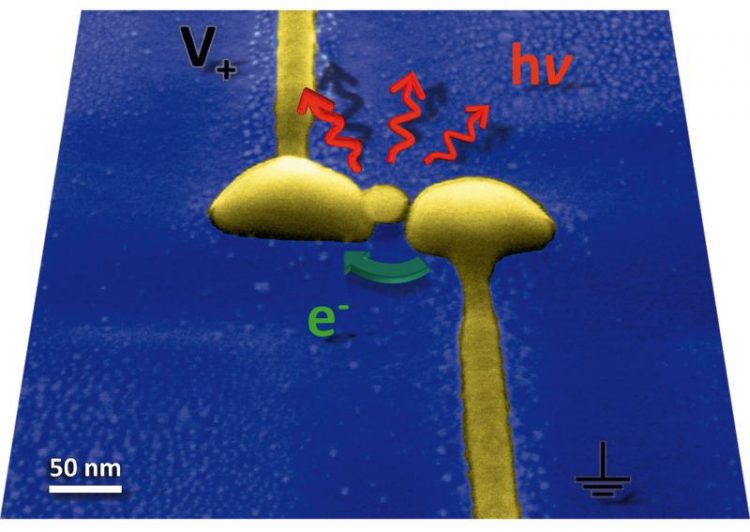The world's first electrically powered optical antenna

A gold particle at its centre: The world's first electrically powered optical antenna was built at the University of Würzburg's Department of Physics. (Picture: Department of Physics)
Electrically powered miniature light sources will be useful in the future, for example, in smartphone displays. Given the increased integration of 3D techniques, the required pixel density should soar in these devices. Nano light sources could also be used on computer chips for low-loss data exchange between processor cores at the speed of light.
Würzburg physicists have shown a way to implementing such light sources in a pioneering piece of work: In the magazine “Nature Photonics” they describe for the first time how light is generated using an electrically powered nanoantenna made of gold. The antenna was developed by Professor Bert Hecht's team and at the Department of Technical Physics.
Applying the laws of antenna technology with light
How does an optical antenna work? “In principle, it works in the same way as its big sister, the radio antenna,” Bert Hecht explains: An AC voltage is applied that causes electrons in the metal to oscillate. As a result, the antennas emit electromagnetic waves of a defined shape and wavelength specified by the antenna geometry.
Transferring the laws of antenna technology to light at nano scale is technically challenging. So the Würzburg physicists had to come up with an idea. In the end, a sophisticated nano structure assured their success: Its optical antenna has two arms each fitted with a contact wire and whose ends almost touch.
The tiny space between the arms is prepared with a gold nano particle which touches the one arm and leaves a gap of about one nanometre to the other arm. The gap is so small that electrons can bridge it due to the quantum mechanical tunnel effect when applying voltage, causing oscillations with optical frequencies.
The length of the antenna arms determines the colour of the light
The antenna thus constructed emits electromagnetic waves in the form of visible light. The colour of the light is determined by the length of the antenna arms. “This has allowed us to build the world's most compact electrically powered light source to date whose properties can moreover be controlled by adjusting the antenna geometry,” Hecht further.
So in principle, such antennas can be built; however, much work needs yet to be done until they are ready for use. For one thing, the physicists have to further improve the efficiency: Too much electricity is lost as heat when operating the optical antenna. For another, the operational stability has to be increased, as the golden nano structure has only worked for a few hours so far.
“Electrically driven optical antennas”, Johannes Kern, René Kullock, Jord Prangsma, Monika Emmerling, Martin Kamp, and Bert Hecht. Nature Photonics, Advance Online Publication 17 August 2015, DOI: 10.1038/nphoton.2015.141
Contact
Prof. Dr. Bert Hecht, Department of Physics, University of Würzburg, Phone +49 931 31-85863, hecht@physik.uni-wuerzburg.de
Media Contact
All latest news from the category: Physics and Astronomy
This area deals with the fundamental laws and building blocks of nature and how they interact, the properties and the behavior of matter, and research into space and time and their structures.
innovations-report provides in-depth reports and articles on subjects such as astrophysics, laser technologies, nuclear, quantum, particle and solid-state physics, nanotechnologies, planetary research and findings (Mars, Venus) and developments related to the Hubble Telescope.
Newest articles

First-of-its-kind study uses remote sensing to monitor plastic debris in rivers and lakes
Remote sensing creates a cost-effective solution to monitoring plastic pollution. A first-of-its-kind study from researchers at the University of Minnesota Twin Cities shows how remote sensing can help monitor and…

Laser-based artificial neuron mimics nerve cell functions at lightning speed
With a processing speed a billion times faster than nature, chip-based laser neuron could help advance AI tasks such as pattern recognition and sequence prediction. Researchers have developed a laser-based…

Optimising the processing of plastic waste
Just one look in the yellow bin reveals a colourful jumble of different types of plastic. However, the purer and more uniform plastic waste is, the easier it is to…


